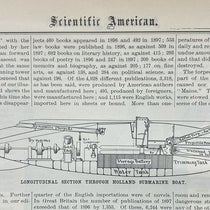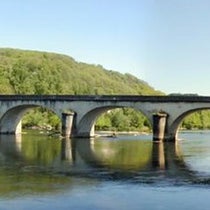Scientist of the Day - Louis Vicat
Louis Vicat, a French engineer and bridge builder, died Apr. 10, 1861, at the age of 75. He attended the École Polytechnique and then the École des Ponts et Chaussées (School of Bridges and Roads), before setting out on a bridge-building career.
Vicat is remembered principally for developing the first artificial cement for use in mortar and concrete. The ancient Greeks and Romans had used cement to build marvelous and durable structures, such as the Pantheon in Rome, which still stands. But their recipe for cement required pozzolan, a volcanic clay, which when mixed with quicklime and water, had exceptional cementing properties. The best pozzolan came from a site near Naples (and Mount Vesuvius), as explained in the only surviving book on ancient architecture, written by Vitruvius.
Engineers in France and England had searched for centuries for a substitute for pozzolan, without much success. John Smeaton, in building the Eddystone lighthouse, had done extensive investigations into cements, and he developed a recipe using ground limestone that worked well for his lighthouse, but other English efforts, such as in building canals, used inferior concrete that soon deteriorated. Engineers in France were in the same situation.
Vicat, around 1812, began his own investigations into substitutes for pozzolan and came up with a viable replacement, using locally available clay and limestone. He was given the contract for building a concrete bridge over the Dordogne River at Souillac, for which he used his artificial cement for part of the bridge, and pozzolan cement for the rest. It was successful – both cements worked equally well – and the bridge, now renamed the Louis Vicat Bridge, still stands (first and third images). Vicat is considered the inventor of artificial cement, although it seems to me that he should share some credit with Smeaton.
Unfortunately for both men, just a few years later, in 1824, Joseph Aspdin in England invented his own artificial cement, which used much cheaper and more commonly found ingredients. He called it Portland cement, and it soon became the norm for concrete engineers, and still is. Vicat wrote a book about his own cement investigations – we have an English translation in our library – but he did not achieve nearly the fame of Aspdin.
We have another book by Vicat in our collections, this one demonstrating that he could build bridges out of iron as well. The book is called Description du pont suspendu: construit sur la Dordogne a Argentat (1830), and it describes and pictures a suspension bridge Vicat designed and erected over the Dordogne River at Argentat. This was only a few years after Thomas Telford had built the Menai suspension bridge in England. Vicat’s bridge shows a debt to Telford, but is unusual in its use of inclined piers and in the way the cables were secured within the masonry of the piers behind. We show the title page and two of the folding engraved plates bound into the back of the book (fourth, fifth, and sixth images). We seldom get the chance to show a binding, but we do so here, because the marbled paper is so unusual (seventh image). The Argentat bridge no longer stands.
Vicat was highly esteemed in his later life, granted an annuity by the state and lauded in a biographical memoir by François Arago. When the Eiffel Tower was erected in 1889, Vicat was one of the 72 chosen to be commemorated on the frieze that circles the tower. Vicat’s name is on the southeast side, toward the left, between Augustin Fresnel and Charles Coulomb (last image).
What accounts for the difference in the present-day reputations of Aspdin and Vicat? Perhaps it has something to do with the fact that Aspdin patented his artificial cement, while Vicat chose not to. Sometimes a gift to one’s peers results in a loss of recognition for the donor. Allowing knowledge to spread freely is not a bad thing, as long as someone later down the line restores credit where it is due. Vicat awaits that biographer.
William B. Ashworth, Jr., Consultant for the History of Science, Linda Hall Library and Associate Professor emeritus, Department of History, University of Missouri-Kansas City. Comments or corrections are welcome; please direct to ashworthw@umkc.edu.














